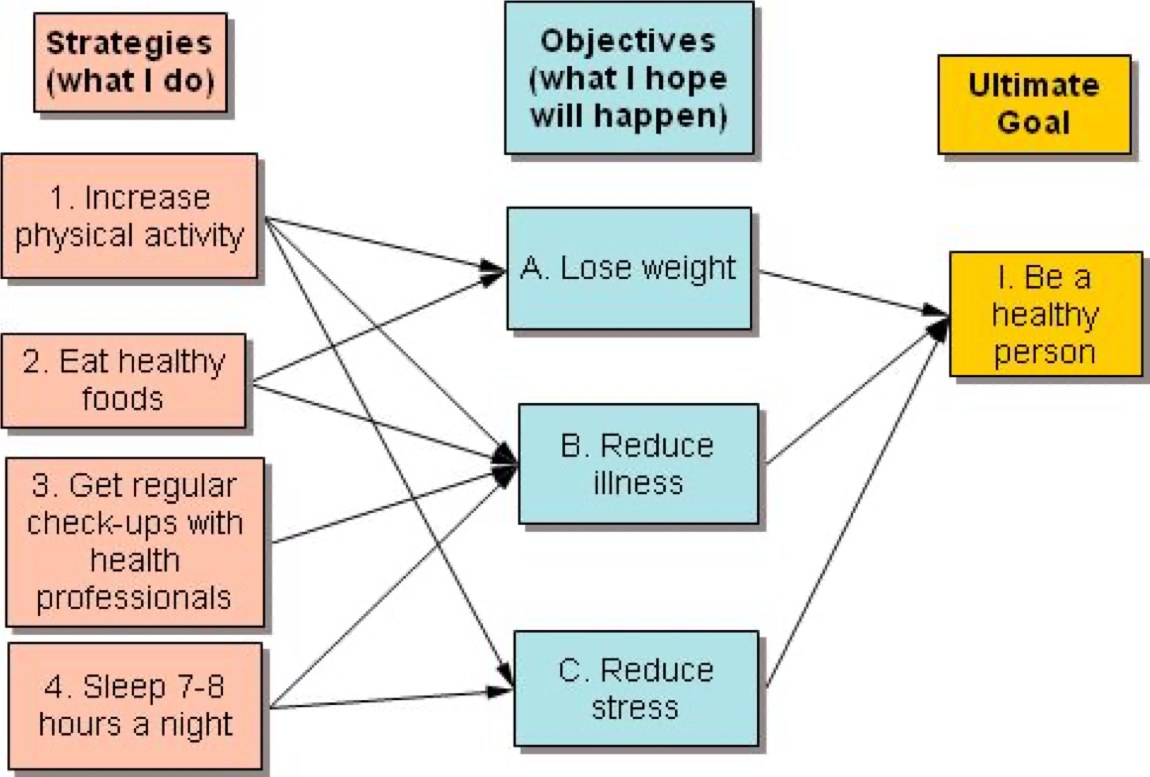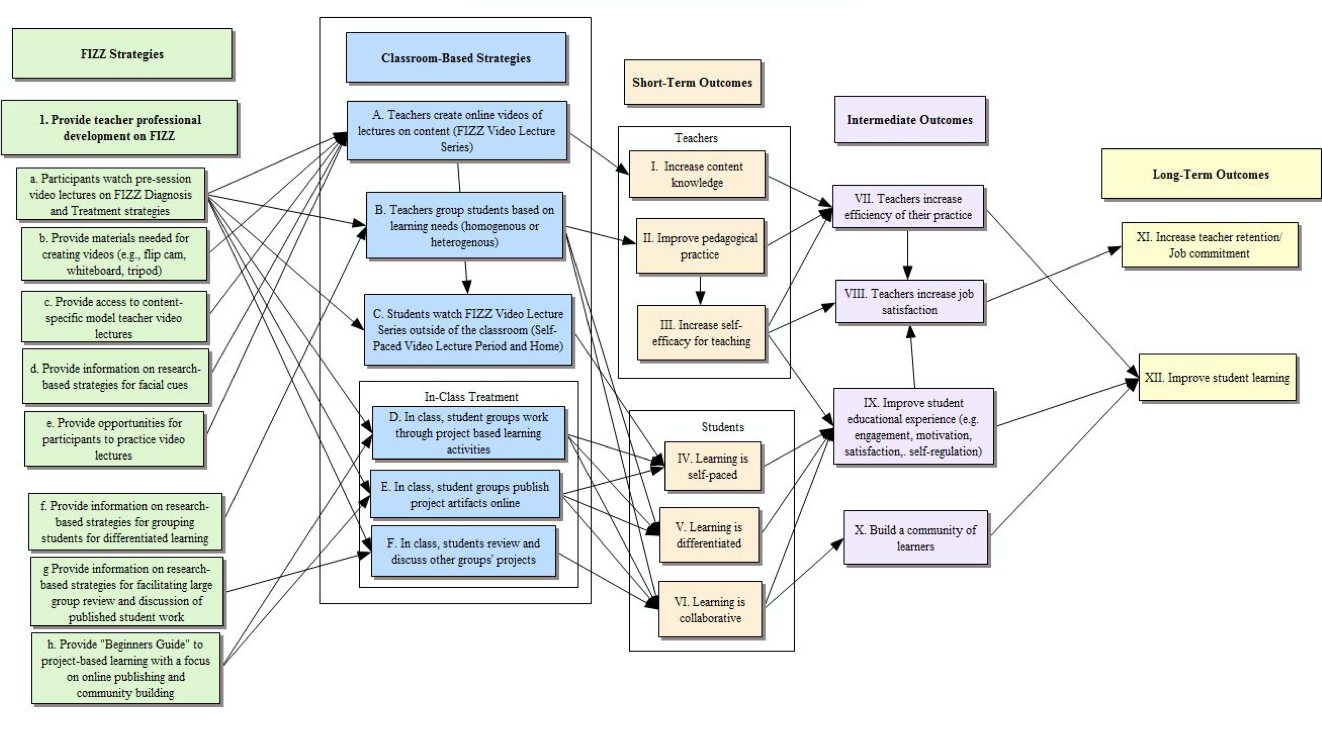Program Planning
Once a vision for digital-age learning has been built and the current status is known, the process of program planning can begin. Typically this will happen in two phases: the development of a logic model (or a theory of action) and then the development of a formal strategic pan.
Logic Models
A logic model is a tool for articulating the key elements of a project to support strategic planning and change management efforts. It’s a graphical representation that can support a clear understanding of the project, goals, and assumptions. It can also be used as a tool for promoting stakeholder buy-in. Logic Models tend to be living documents and are typically revised often throughout a program cycle.

Logic models contain three major elements:
- Strategies/activities - the main activities being done in the project.
- Objectives/outcomes - what you think/hope will happen.
- Ultimate goal - what are you are striving for (this is your vision statement). Note that these terms are not consistently used across all logic model templates, but the general meaning and flow is more important. However, it’s important to distinguish between outputs and outcomes, as they’re often conflated. Outputs are the activities that a project generates (i.e. “all teachers trained in project based learning”) versus outcomes which are the changes that result from outputs (“teachers are effectively using project based learning twice per semester one year after training”). It’s important to capture both in your strategic plan, but to focus on outcomes in your logic model - outputs hopefully will produce the desired outcomes, but they may not. Sometimes it’s necessary to add columns or to group strategies (i.e. “short term vs. long term outcomes” in separate columns or “teacher strategies and student strategies” in separate groups). The logic model should be broken up in a way that it’s the most useful to the team implementing. The linkages between boxes also show which activities yield to which outcomes. Every box should have at least one linkage. Outcomes should have a linkage in from an activity and a linkage out to the ultimate goal. Consider using color in the linkages to make them easier to follow.
Developing your Logic Model
When developing a logic model, it’s typical to start with a vision statement and to articulate that within the model. it sometimes makes sense to break your vision statement down form one box to multiple to simplify the logic model and make it easier to articulate.
Second, develop your activities and strategies to answer the question - “What are the major activities?” and “What is being done to get from here to there?”. This often includes policy development, funding and purchasing, new curricula, professional learning, and marketing. Activities should be worded simply and be straightforward and easy to understand. Keep the grain-size of the activity small enough to capture the individual activities, but not so small that everything is captured and the model becomes overwhelming. Typically activities won’t include the word “and” - each activity should be singular and distinct.
Third, develop your outcomes. Outcomes are the statements that connect your activities to your ultimate goal and answer the question “what will happen as the result of the project activities?” This typically takes the form of changes in practice or engagement or attendance or test scores. Again, be sure to develop outcome statements and not outputs (include outputs in a separate column if it’s helpful). Sometimes outcomes will be broken up temporally (short term, medium term, long term) or by audience (student outcomes, teacher outcomes). Outcomes should be descriptive and should answer the questions “who” and “what” and should use quantity or frequency descriptors like “more” or “fewer” or “every three months”. Like activities, outcomes should be singular and distinct.
Fourth, develop your linkages. Like in most process diagram, the actual work to be done is in the arrows and not in the boxes. Linkages represent where work has to be done to move from activity to outcome to vision. You can have as few or as many linkages as you need, but be aware of root causes - it can be tempting to say that every activity impacts every outcome, but in the process of developing linkages, be sure to consider whether the activity has a direct impact on the outcome listed.
Color-coding any element in a logic model can be helpful for improving readability or in helping to better articulate relationships.
The logic model below was developed by Dr. Jeni Corn for a flipped classroom model called FIZZ, developed by Dr. Lodge McCammon. Notice that the activities are broken up by programmatic activities in FIZZ and by classroom activities and that outcomes are broken into short-term and intermediate outcomes.

Strategic Plans
Once a logic model has been developed the next step is to turn the model into a strategic plan. A strategic plan turns the logic model into an operational document - the details of the step-by-step plans and measures and evaluation criteria that the program will use. The logic model moves to the strategic plan typically through a process like a SWOT analysis. SWOT stands for strengths, weaknesses, opportunities, and threats. The SWOT analysis examines your linkages in your logic model and the activities and outcomes that you’ve identified. In the process of developing the SWOT analysis, you should be thinking about how to leverage strengths and opportunities to overcome weaknesses and threats. This SWOT template, provided by ISTE, is a good place to start:
 Source: ISTE
Source: ISTE
Once you understand your current status, the process of writing your strategic plan can begin. The first part of a strategic plan should document the current status, the vision for change, the data collection process, and the desired outcomes and ultimate goals. Then within each section, you would have a goal statement that correlates back to the outcomes in the logic model. Goal statements should be SMART - Specific, Measurable, Attainable, Realistic, and Time-Bound.. To support each goal, list the current status, a set of activities and then the sub-activities in granular detail, the responsibility and timeline for each, the budget needed, and the evaluation criteria. Evaluation criteria can be used to evaluate whether an output was completed successfully and whether the outcome was met. This can take a lot of different formats. Review this sample technology plan.